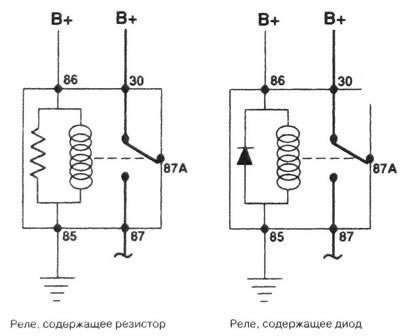General information
1. In some electrical circuits, such as the injection system, horn, starter and fog lights, current is supplied to the components by passing through a relay. The relay has a low voltage circuit (control circuit), which controls the high voltage circuit (power circuit). When a relay fails, the normal operation of the corresponding circuit device is disrupted. Relays are installed in both the outdoor and indoor units (see illustrations 3.1c and 3.1f). If the relay is suspected to be faulty, remove it and check it using the procedure described below, or take it to a service and repair station for diagnosis. Faulty relays cannot be repaired.
Functionality check
2. Most of the relays used in the design of the described vehicles comply with the ISO standard. The numbering of the contact pins of such relays corresponds to the closed circuits. There are two main types of relays used in these vehicles (see illustrations).

5.2a. Design, numbering of contact pins and connection diagram of relay circuits complying with the ISO standard

5.2b. Most relays have a power and control circuit identification marking on the outside - a relay with four pins is shown
3. Refer to the electrical diagrams and determine the connection points of the devices for diagnosing the relay. If it is not possible to determine the connection points from the diagrams, determine them based on the recommendations given below.
4. Most relays have two control circuit terminals (the contact terminals are connected to the relay winding, which, when excited, closes the contacts, which ensures the inclusion of the power circuit). The remaining contact pins of the relay belong to the power circuit (they are closed when the control circuit winding is energized).
5. Pins 85 and 86 belong to the control circuit. If the relay contains a diode, connect pin 86 to the positive terminal of the battery (B+), and contact 85 - to the ground loop. The corresponding contacts of a relay containing a resistor are connected in the same way.
6. Pin 30 is connected to the power circuit (B+) when the chain is loaded. Pin 87 is connected to the power terminal of the circuit device. If the relay has several additional contact pins for connection to the power and ground circuit, these contacts are designated 87A, 87B, 87C IT. d.
7. Check the relay control circuit coil using an ohmmeter.
- A) Connect the meter using the polarity shown in the illustration for one of the tests, then reverse the ohmmeter electrodes and test for an open circuit.
- b) If the relay contains a resistor, the device will display the presence of resistance, which will be equal to the resistance displayed by the device when the electrodes are connected in reverse.
- With) If the relay contains a diode, then the resistance recorded by the ohmmeter when the electrodes are initially connected will be higher than the resistance displayed by the device when the electrodes are connected in reverse.
- d) If the ohmmeter registers infinite resistance in both directions, replace the relay.
8. Remove the relay and, using an ohmmeter, check the area between the contact terminals of the power circuit for an open circuit. When the relay is not connected, the circuit between pins 30 and 87 must be open.
9. Connect the jumper wire containing the fuse between pin 86 and the battery positive terminal. Connect another jumper between pin 85 and the ground point. After both jumpers are closed, the relay should click.
10. Without disconnecting the jumpers, check the circuit between the contact terminals of the power circuit for an open circuit. In this case, the circuit must be closed between relay contact terminals 30 and 87.
11. If the relay fails any of the tests described above, replace it.
